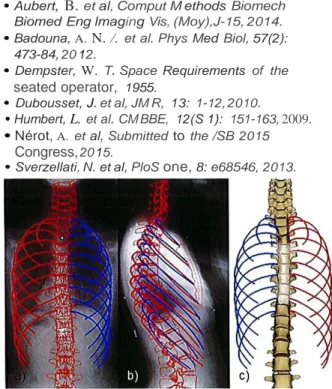Science Arts & Métiers (SAM)
is an open access repository that collects the work of Arts et Métiers Institute of
Technology researchers and makes it freely available over the web where possible.
This is an author-deposited version published in: https://sam.ensam.eu
Handle ID: .http://hdl.handle.net/10985/19076
To cite this version :
Célia AMABILE, Julie CHOISNE, Agathe NÉROT, Hélène PILLET, Wafa SKALLI - Prediction of
the rib cage volume and thorax density from anthropometric data. - In: 21st Congress of the
European Society of Biomechanics, République tchèque, 2015-07-05 - Prediction of the rib cage
volume and thorax density from anthropometric data - 2015
Any correspondence concerning this service should be sent to the repository
Administrator : archiveouverte@ensam.eu
• , • 3
)
PREDICTION OF THE RIB CAGE VOLUME AND THORAX
DENSITY FROM ANTHROPOMETRIC DATA.
C. Amoblle 1 2 J. Choisne 1, A. Nérot 1
, H. Plllet 4 , W. Skolll 1
1 Arts et Métiers ParisTech, Institut de Biomécanique Humaine Georges Charpak / LBM , Paris, France
2 NYU Hospital for Joint Diseases, Depart ment of Orthopedic Surgery, New York City, USA 3 IFSTTAR, UM R_T9406, LBMC Laboratoire de Biomécanique et Mécanique des Chocs,
Bron, France
•Arts et M étiers ParisTech, Institut de Biomecanique Humaine Georges Charpak / LBM ,
Paris, France
I NTROD U CT ION
Rib cage volume and thorax density are useful both for clinical issues (Sverzellati et al. 2013) and for
multi-segmentol body modeling . ln the latter case
meon density is generolly ossumed, using dota from
Dempster et al (Dempster 1955), which could be over-eva luoted due to the Iock of considerotion of
lung density. Bi-plonor X-R oy system (Dubousset et
al. 20 l0) combined with 30 reconstruction ollows
to get both the rib cage and the externol body shope. The oim of this study is to estimote the rib
cage volume compared to the thorax volume and
to propose a refined thorax density estimation. METHODS
55 osymptomotic volunteers were considered ( 35
moles. 20 femoles); meon age: 38.3 y.o. [20-85] and meon body mass index (BMI) : 22.9 kg/m2
[ 15.4-29 .5]. Head to feet low dose bi-plonor
X-Rays were ocquired using the EOS system (EOS lmaging, Paris, France) follow ed by performing the 30 reconstruc tions of the spine, rib cage and
externol body shope (Humbert et al. 2009; Aubert
et al. 20 14; Nérat et al. 20 15) (Figure l) . Bone, Rib cage and thorax volumes (TV) were computed
( from T lIo T l2 levels) . Lung volume was estimated
os the inner rib cage volume (RCV) minus the heart volume computed from the literature (Badouna et al. 2012) . Multi-linear regression was consideredIo
search for correlation between RCV and regressors
such os TV , BMI. Age and Gender. Gender was setIo
l for Male subject and 0 for Female subject. Criteria Io determine the ideal number of regressors were:
the leave-one-out-error ( LOOE) , the R-squared stotistics (R2) , the p-value {pval) and the standard
error of estimate (SEE) . Moreover, global thorax density was calculated using literature reported densities of eac h component {bone, lung, heart and soft tissues) , and their respective colculo ted
volumes. R ESULTS
Mean RCV was 7793 cm3 (SD: 1 675) and mean
reconstructed TV was 18020 cm3 (SD: 4528) .
The most relevant predictive equotion was:
RCV (cm3)
=
0.336 • TV (cm3) + 151.4 • Gender + 1609 .2.Prediction of the RCV was significant with p < 0.05 and R2 = 0.88. SEE and LOOE were respectively 7 .3 3 and 7.8 3 of the mean RCV. Mean density was 0.80 g/cm3 (SD 0.007) .
DISCUS SION
This study brings a new evoluotion of the rib cage
volume from onthropometric parometers. This
could serve os a reference when studying rib cage
variability for pothologicol population.
Il olso ollows prov iding a refined value of global
thorax density, which is lower thon the one
proposed by Dempster et al. (0.92 g/cm3 , and could be more relevant for multibody humon
models. REFER ENCES
•Aubert, B. et al, Comput M ethods Biomech
Biomed Eng lmaging Vis, (Moy),J-15, 2014.
•Badouna, A. N. /. et al. Phys Med Biol, 57(2): 473-84, 20 12.
•Dempster, W. T. Space Requirements of the
seated operator, 1955.
•Dubousset, J. et al, JM R, 13: 1-12, 2010.
•Humbert, L. et al. CM BBE, 12(S 1): 151-163, 2009. •Nérot, A. et al, Submitted to the /SB 2015
Congress, 20 15.
Figure 1: a) & b) Bi-planar radiographies with reconstructed spine and rib cage. c) 30 reconstruction of the
spine and rib cage.
